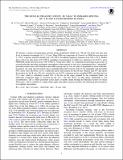Files in this item
The MUSCLES Treasury Survey. III. X-ray to infrared spectra of 11 M and K stars hosting planets
Item metadata
| dc.contributor.author | Loyd, R. O. P. | |
| dc.contributor.author | France, Kevin | |
| dc.contributor.author | Youngblood, Allison | |
| dc.contributor.author | Schneider, Christian | |
| dc.contributor.author | Brown, Alexander | |
| dc.contributor.author | Hu, Renyu | |
| dc.contributor.author | Linsky, Jeffrey | |
| dc.contributor.author | Froning, Cynthia S. | |
| dc.contributor.author | Redfield, Seth | |
| dc.contributor.author | Rugheimer, Sarah | |
| dc.contributor.author | Tian, Feng | |
| dc.date.accessioned | 2016-07-29T15:30:13Z | |
| dc.date.available | 2016-07-29T15:30:13Z | |
| dc.date.issued | 2016-06-20 | |
| dc.identifier | 244634858 | |
| dc.identifier | 6cf0fc33-01ae-47dd-9d9e-ff4da48bf1df | |
| dc.identifier | 84978394343 | |
| dc.identifier | 000381912800038 | |
| dc.identifier.citation | Loyd , R O P , France , K , Youngblood , A , Schneider , C , Brown , A , Hu , R , Linsky , J , Froning , C S , Redfield , S , Rugheimer , S & Tian , F 2016 , ' The MUSCLES Treasury Survey. III. X-ray to infrared spectra of 11 M and K stars hosting planets ' , Astrophysical Journal , vol. 824 , no. 2 , 102 . https://doi.org/10.3847/0004-637X/824/2/102 | en |
| dc.identifier.issn | 0004-637X | |
| dc.identifier.other | ORCID: /0000-0003-1620-7658/work/27162476 | |
| dc.identifier.uri | https://hdl.handle.net/10023/9227 | |
| dc.description | S.R. would like to acknowledge support from the Simons Foundation (339489, Rugheimer). F.T. is supported by the National Natural Science Foundation of China (41175039) and the Startup Fund of the Ministry of Education of China (20131029170). This work was partially supported by Chandra grants GO4-15014X and GO5-16155X from Smithsonian Astrophysical Observatory and NASA XMM grant NNX16AC09G. | en |
| dc.description.abstract | We present a catalog of panchromatic spectral energy distributions (SEDs) for 7 M and 4 K dwarf stars that span X-ray to infrared wavelengths (5 Å -5.5 μm). These SEDs are composites of Chandra or XMM-Newton data from 5-∼50 Å, a plasma emission model from ∼50-100 Å, broadband empirical estimates from 100-1170 Å, Hubble Space Telescope data from 1170-5700 Å, including a reconstruction of stellar Lyα emission at 1215.67 Å, and a PHOENIX model spectrum from 5700-55000 Å. Using these SEDs, we computed the photodissociation rates of several molecules prevalent in planetary atmospheres when exposed to each star's unattenuated flux ("unshielded" photodissociation rates) and found that rates differ among stars by over an order of magnitude for most molecules. In general, the same spectral regions drive unshielded photodissociations both for the minimally and maximally FUV active stars. However, for O3 visible flux drives dissociation for the M stars whereas near-UV flux drives dissociation for the K stars. We also searched for an far-UV continuum in the assembled SEDs and detected it in 5/11 stars, where it contributes around 10% of the flux in the range spanned by the continuum bands. An ultraviolet continuum shape is resolved for the star Eri that shows an edge likely attributable to Si ii recombination. The 11 SEDs presented in this paper, available online through the Mikulski Archive for Space Telescopes, will be valuable for vetting stellar upper-atmosphere emission models and simulating photochemistry in exoplanet atmospheres. | |
| dc.format.extent | 19 | |
| dc.format.extent | 2262922 | |
| dc.language.iso | eng | |
| dc.relation.ispartof | Astrophysical Journal | en |
| dc.subject | Stars: low-mass | en |
| dc.subject | Ultraviolet: stars | en |
| dc.subject | X-rays: stars | en |
| dc.subject | QB Astronomy | en |
| dc.subject | QC Physics | en |
| dc.subject | Space and Planetary Science | en |
| dc.subject | Astronomy and Astrophysics | en |
| dc.subject | NDAS | en |
| dc.subject.lcc | QB | en |
| dc.subject.lcc | QC | en |
| dc.title | The MUSCLES Treasury Survey. III. X-ray to infrared spectra of 11 M and K stars hosting planets | en |
| dc.type | Journal article | en |
| dc.contributor.institution | University of St Andrews. Earth and Environmental Sciences | en |
| dc.identifier.doi | https://doi.org/10.3847/0004-637X/824/2/102 | |
| dc.description.status | Peer reviewed | en |
| dc.identifier.url | http://www.scopus.com/inward/record.url?scp=84978394343&partnerID=8YFLogxK | en |
This item appears in the following Collection(s)
Items in the St Andrews Research Repository are protected by copyright, with all rights reserved, unless otherwise indicated.

